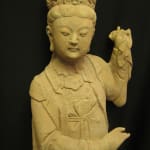Ming Dynasty Sandstone Standing Bodhisattva, 1368 CE - 1644 CE
Sandstone
11.81 x 33.26 x 11.41
DL.2100
Further images
Buddhism travelled to China from India along the Silk Road during the 1st Century AD. By the period of the Tang Dynasty (618-906 AD) it had become central to Chinese...
Buddhism travelled to China from India along the Silk Road during the 1st Century AD. By the period of the Tang Dynasty (618-906 AD) it had become central to Chinese religious culture. This sculpture, dating to the Ming Dynasty, represents a bodhisattva standing on a rectangular plinth. The figure is positioned with its weight resting on the left leg, while the right is delicately extended to the front of the base. The left arm is raised and a cloth has been expertly carved to fall between the figure’s fingers. The right arm is extended across the body at waist level, with the drapery falling over the front.
The elaborate headdress is typical of a bodhisattva. Buddhas, by contrast, were typically depicted modestly clothed. A bodhisattva is an enlightened being who has chosen to delay entry into Nirvana and remain in the world to help other sentient beings achieve enlightenment. This mission is reflected in the figure’s sympathetic visual expression; the rounded face, small mouth and well-defined chin suggest a child-like appearance. This is also implied by the playful sense of movement. In contrast to more static, meditative bodhisattvas, this figure is lively and enchanting.
The elaborate headdress is typical of a bodhisattva. Buddhas, by contrast, were typically depicted modestly clothed. A bodhisattva is an enlightened being who has chosen to delay entry into Nirvana and remain in the world to help other sentient beings achieve enlightenment. This mission is reflected in the figure’s sympathetic visual expression; the rounded face, small mouth and well-defined chin suggest a child-like appearance. This is also implied by the playful sense of movement. In contrast to more static, meditative bodhisattvas, this figure is lively and enchanting.





